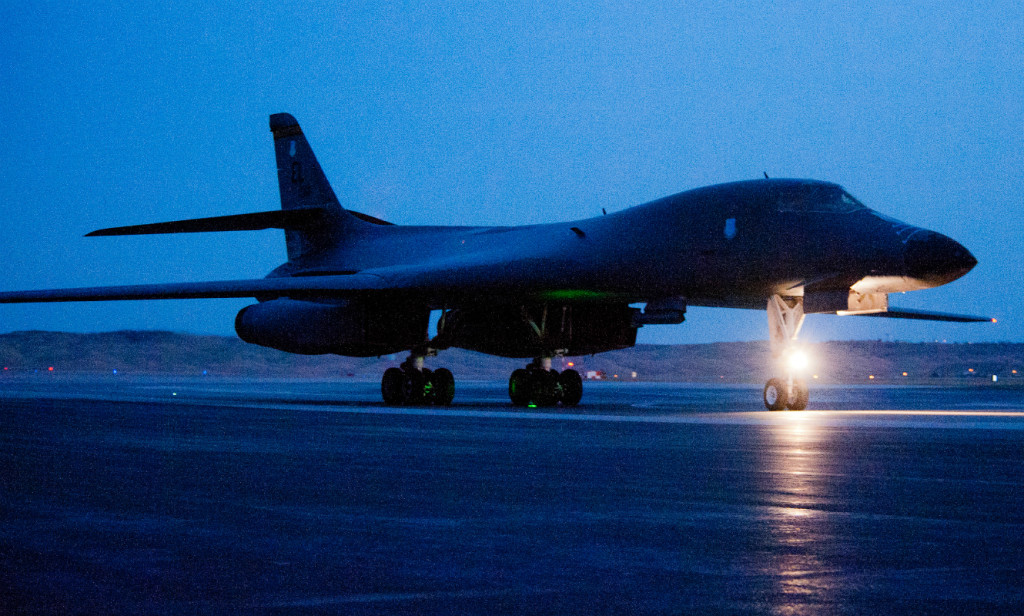What the U.S. Military Needs for an Era of Growing Threats

On Tuesday, the Pentagon awarded the Long Range Strike Bomber (LRS-B) contract to Northrop Grumman. Once in operation, the LRS-B will serve as a long-awaited replacement for a tired fleet of B-1 and B-52 bombers. Still, the future of the LRS-B and many other modernization programs remains threatened by continuing resolutions and other temporary solutions that cannot, whether by law or capacity, support multi-year development and procurement programs.
Without the assurance of steady, adequate funding, Air Force systems and capabilities will continue to age and deteriorate, and the LRS-B and other modernization programs will proceed uncertainly. Each service branch faces similar risks as budget caps continue to direct defense spending priorities, forcing decision-makers to accept future costs in order to preserve short-term strength. These are the decisions that the Heritage Foundation’s annual “Index of Military Strength” seeks to inform through an assessment of “the ability of the nation’s military forces to protect vital national security interests.”
The Index’s assessments and recommendations are based on a force-sizing construct that has been the standard since the end of the Cold War. It requires the military to maintain sufficient strength to fight and win one war while retaining the ability to fulfill ongoing requirements around the world, reassure U.S. allies, deter potential aggressors, and fight in a simultaneous or overlapping conflict if necessary. However, as budget caps force the military to accept cuts to personnel, training, maintenance and modernization, the military’s ability to meet these requirements is increasingly strained. As a result, each service has made tradeoffs between operational readiness levels, modernization of critical systems and equipment, and the preservation of the force size and strength.
The Army faces rapid, ongoing troop drawdowns. Its current end strength stands at only 490,000 active component soldiers, a number that is slated to bottom out at an end strength of 450,000 — the bare minimum required to meet its national security requirements as determined by the 2015 Army Posture Statement. Modernization programs to replace or upgrade worn and outdated ground combat vehicles and rotorcraft have been restructured, delayed, or canceled to preserve operational readiness.
The total aircraft inventory of the Air Force currently exceeds defense requirements. However, this fleet’s age and limited capabilities will soon threaten its ability to stand up to advanced aircraft and weapons systems in development by potential adversaries. Upgrading these capabilities relies heavily on replacing a large portion of the current inventory with the F-35A and LRS-B. But the future of that strategy is threatened by budget caps and unforeseen costs and delays associated with testing and development.
The Navy’s current battle force fields only 271 of the 346 ships recommended by the 2016 Index. Current shortages and a growing backlog of ship maintenance already restrict the military’s forward presence. For the first time in almost a decade, the United States lacks a carrier presence in the Middle East, as the Navy awaits the arrival of its newest carrier. Meanwhile, Russia, Iran and the Islamic State continue to increase their activities in the region.
End strength reductions left the Marine Corps with 23 infantry battalions (the USMC’s basic combat unit) in fiscal year 2015, two fewer than FY2014 levels and dangerously short of the 36 battalions recommended by the Index for a fully capable force.
The current U.S. nuclear force depends on a limited and aging set of weapons and delivery systems. Given the increasingly aggressive nuclear programs of competitor states, the status of U.S. nuclear capabilities — which lack plans and funding for modernization — is of growing concern.
As a result of these shortfalls, among a growing list of deficiencies, the 2016 Index assesses U.S. military strength as far short of the force needed to meet growing threats and minimum requirements. Each service is “beset by aging equipment, shrinking numbers, and rising costs — and this at a time when threats to U.S. interests continue to rise.” In order to halt the decline in U.S. military strength and fully address national security needs, force requirements must be met with commensurate defense spending levels.
Dakota L. Wood is a senior research fellow in The Heritage Foundation’s Allison Center for Foreign and National Security Policy and the editor of the “2016 Index of U.S. Military Strength.” Rachel Zissimos is a research assistant at the Allison Center.
Photo credit: Airman 1st Class Kate Thornton, U.S. Air Force

